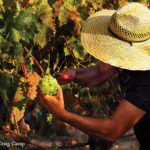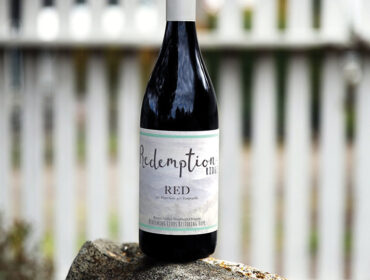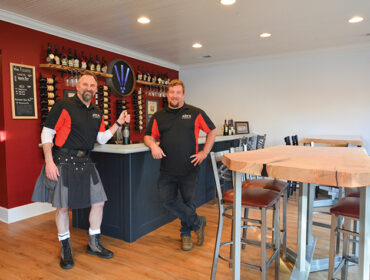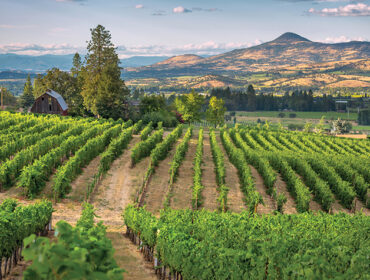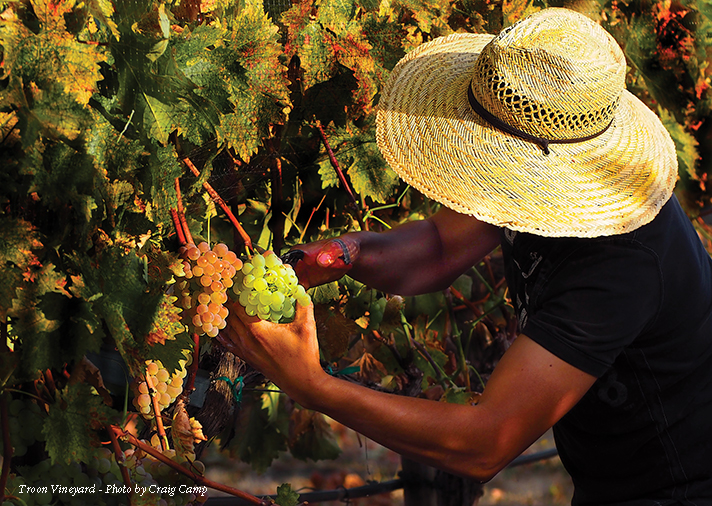
A Year in the Life of a Winery: Harvest – by MJ Daspit
HARVEST MAKES US THINK OF PICKING DEEP PURPLE, LUSCIOUSLY-RIPE BUNCHES OF GRAPES. It’s the joyous time of gathering-in, reaping the fruits of a season’s work in the vineyard. The grower, who has spent sleepless nights worrying about frost, and long days fighting mildew, insects and predation by animals ranging from birds to bears, can finally breathe a sigh of relief and relax. And the winemaker? Well, to tell the truth, the winemaker’s long days have just begun.
According to winemaker Linda Donovan, owner of Pallet Wine Company in Medford, the Rogue Valley’s first custom crush winery, harvest means working 24/7 if necessary. At Pallet, Donovan will process 600 tons of grapes this fall for a variety of clients all over Oregon. This represents an incredible challenge given the unpredictability of Mother Nature, different ripening conditions in various parts of the state and the preferences of each client as to desired ripeness and flavor profile in the fruit that will drive different styles of wine. “We rely on our grower partners to communicate with us on when they’ll pick and deliver fruit. Ideally we would receive that fruit early in the morning and process it before the heat of the day, but even at a large scale facility like Pallet, there’s only so much we can do in a day. To make sure it all works, a lot of flexibility is needed on both ends.”
So when does the mayhem in the winery begin? In general terms, the Rogue Valley harvest occurs between Labor Day and Halloween. During that period, different varieties of grapes ripen at different rates and will be picked at different times. The degree of ripeness is a factor in deciding when to pick. The riper the fruit, the higher the sugar level (what the winemaker calls brix) and potential alcohol in the wine.
Chris Graves of Naumes Crush and Fermentation, the latest custom crush winery to open in Southern Oregon, explains, “When I’m looking at the picking decision, flavor is the most important factor, especially with red grapes. Working with custom crush clients, the picking decision depends on the style they’re after. For a syrah, they may want a cooler climate version, a peppery, lower alcohol, lean syrah. Others might be interested in a real jammy, savory ripe style. It might come down to when they have crews available and that’s becoming more of an issue—it’s a real juggling act of what’s ready or close enough to be picked along with when it can be picked on the side of the client/grower/crew and when we can receive it and crush it.”
Even with that case-by-case decision on the right moment to pick, the reality is a huge amount of fruit comes into the winery all at once. For Graves at Naumes, that will be 300-500 tons this year. How does he manage the deluge of grapes?
“The big tool I have at this winery is cold storage which makes a big difference. At the standard winery you call that pick in and you’re expecting that fruit early in the morning when it’s nice and cool so your whole day is based around that. But there can be problems. One example might be you don’t get enough crews in and the picking takes a long time. From the winery’s perspective, I’m expecting this batch of fruit to come in, I get my guys all on board, we gear up everything, the whole crush pad’s ready to go and then we’re waiting for the fruit. And sometimes it might not come in until late in the day or something falls apart and it doesn’t come in at all. Time is of the essence and whenever that fruit arrives, you need to process it right away. Having cold storage changes all that. As long as the grapes are sound, hand-picked and clean, you can put them into cold storage for a night or two and process them when it makes sense, given the loading on the crush pad. That flexibility makes a huge difference because it’s no problem if a grower picks on Sunday or the grapes come in at 7pm.”
As harvest progresses, the main job boils down to accomplishing a myriad of detailed tasks on a regular basis. Donovan describes the routine. Morning chores consist of measuring sugar levels and punching down the lots already in fermentation, setting up the crush pad to receive new fruit, weighing the tonnage when new fruit arrives, destemming the reds and putting juice and grape solids into fermentation tanks, and pressing the white grapes and pumping juice into tanks for fermentation. Morning chores can continue on into the night.
Afternoon chores include cleaning, cleaning and cleaning. Pallet is located in the historic Cooley Neff building, so, Donovan points out, “it will never be sterile, but all the winery surfaces are continuously hosed down with water and surface contact sterilant. We hose down the floors 30 times a day, so there’s no standing around.” Destemming grapes produces a huge amount of green waste which is composted through Rogue Disposal. With all that exposure to sticky grape juice, Donovan says, “We change clothes more than once a day. It’s hands-on and traditional. We’re not afraid to get dirty.”
Graves sees the ongoing work in terms of decision-making. “There are lots of different processes when it comes to fermentation—the egg (a ceramic ovoid fermenter manufactured by Sonoma Stone), the small tanks, the large tanks with O2 infusion. Whole berry or cluster? In a perfect world where logistics doesn’t come into play it’s a stylistic choice, so a lot of times what I’m going to do is reverse engineer a style the client wants. That will dictate the vinification methods and the processing. For instance, I might choose to do crushed fruit versus whole berry and add whole clusters back. There are also decisions on fermentation temperature, cap management and so on that come down to style. But always coupled with that is the logistics and what I can accomplish with my resources and certain lot sizes.”
Summing it up, he adds, “The main thing to point out that most people don’t understand, is how crazy harvest is. It’s just chaotic, busy and intense. My day starts at 6am and often doesn’t finish till 9pm and there’s very little down time. It’s switching gears all day long, reprioritizing, a lot of coordinating and go, go, go. Another thing people don’t understand is how hard winery work is. My first mentor was one of the original winemakers at Wente in Livermore. At the beginning of my initial internship he said winemaking is basically making messes and cleaning them up again. And it’s true. It’s probably 80% cleaning—scrubbing, pressure spraying, washing, rinsing—making sure there’s nothing for bad bacteria to get started in. Sometimes on the crush pad it’s really hot, there are yellow jackets, bees and earwigs all over you and there’s grape juice in your eyes. It’s funny because when I first started in the wine business I knew it was hard work, a lot of hose dragging, but I didn’t realize the intensity of it.”
Still, amid all the hard work, Graves says harvest is exhilarating. “It’s joyous, picking those bunches of grapes, the smells of fermenting wines, tasting during the process. You get these quick rewards, but the greatest thing is how busy it is and how everything’s different and changing. I’ll be in the vineyards one minute and the lab the next minute; I’ll be punching down the next minute; I’ll be tasting most of the day. It’s dynamic and it’s intense, good energy.”
And when is the winemaker done? Donovan says, “You’re never buttoned up until the last wine of a vintage is in bottle.” Let’s see … if she’s bottling over 40 thousand cases this year, I guess that holiday vacation will just have to wait!
©Southern Oregon Wine Scene – from the Fall Winter 2019 issue
Related Post
RoxyAnn Winery–Making a Difference with Redemption...
Update to this article on 07/29/21 – “… the Board of Directors of Redemption Ridge have made the difficult decision to clo...
Awen Winecraft: An Inspirational New Reason...
As if you needed another reason to visit historic Jacksonville, now there’s another draw—Awen Winecraft’s new tasting room located at ...
Rogue Valley Rising – by Valerie...
MEDFORD, OREGON’S star is rising on the world stage as it rapidly becomes a top destination for connoisseurs of fine wine and for enthusia...
